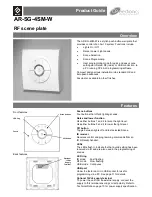
38
ATtiny26(L)
1477G–AVR–03/05
Note that if a level triggered external interrupt or pin change interrupt is used from
Power-down mode, the changed level must be held for some time to wake up the MCU.
This makes the MCU less sensitive to noise.
If the wake-up condition disappears before the MCU wakes up and starts to execute,
e.g., a low level on INT0 is not held long enough, the interrupt causing the wake-up will
not be executed.
Standby Mode
When the SM1..0 bits are “11” and an External Crystal/Resonator clock option is
selected, the SLEEP instruction forces the MCU into the Standby mode. This mode is
identical to Power-down with the exception that the Oscillator is kept running. From
Standby mode, the device wakes up in only six clock cycles.
Notes:
1. Only recommended with external crystal or resonator selected as clock source.
2. Only level interrupt INT0.
Table 19. Active Clock Domains and Wake-up Sources in the different Sleep Modes.
Active Clock domains
Oscillators
Wake-up Sources
Sleep Mode
clk
CPU
clk
FLASH
clk
IO
clk
ADC
Main Clock
Source Enabled
INT0, and Pin
Change
USI Start
Condition
EEPROM
Ready
ADC
Other I/O
Idle
X
X
X
X
X
X
X
X
ADC Noise
Reduction
X
X
X
X
X
X
Power-down
X
X
Standby
X
X
X
















































